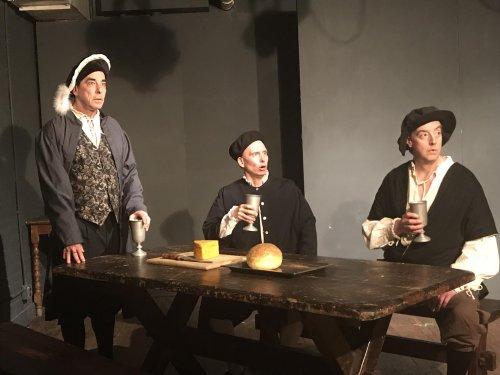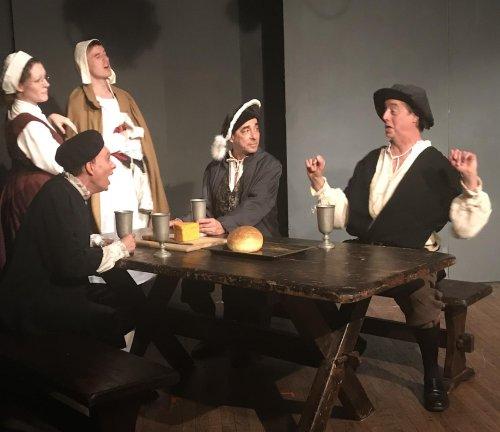Marlowe’s Fate
Fanciful play based on the theory that Marlowe was not killed in a bar brawl and that Shakespeare fronted for him ever after.

Thomas Grube, Brady Adair and Len Rella in a scene from Peter B. Hodges’ “Marlowe’s Fate” (Photo credit: Peter B. Hodges)
[avatar user=”Victor Gluck” size=”96″ align=”left” ] Victor Gluck, Editor-in-Chief[/avatar] The premise behind the fanciful Marlowe’s Fate by writer/director Peter B. Hodges is that Elizabethan playwright Christopher Marlowe was not murdered in Mrs. Bull’s eating establishment in Deptford, London, on the night of May 3, 1593 but his death was faked and he was sent out of the country to save his life. If you believe this than you also believe (as the play’s second act presumes) that buffoonish William Shakespeare (here called “Shaxper”) fronted for him and wrote no plays of his own. Although the theory that Marlowe was not murdered on that night has continued to be bruited about after many years of being debunked, it all comes back to the idea that country boy Shakespeare, who did not attend university, could not possibly have written all of his great plays and poems.
This theory fails to take into consideration that what Shakespeare studied at Stratford’s King Edward IV Grammar School (Latin and classical authors, the history of the kings of England, and the entire Bible) was enough to make him a very educated man. As a country boy, Shakespeare knew more about nature than the other playwrights of this time and that many Elizabethan plays were rewrites of earlier plays, the lost Ur-Hamlet, for instance. Even more striking is that his father as alderman and bailiff of Stratford had the job of licensing all traveling plays that came through town and the young Shakespeare most likely attended all or most of these with his father. This would have been a fine theatrical education.
Finally, many of the dramatic writings of the so-called university wits who wrote for the theater are deadly stilted and static, really poor translation/adaptations of Latin precursors that had been assigned. The extant Shakespeare plays are nothing like Marlowe’s which are based on extensive monologues with most of the action off stage. To date, there is no conclusive evidence that university trained Marlowe or Frances Bacon or a number of other candidates wrote Shakespeare’s plays. And if, as is generally believed, that Shakespeare was an actor and company member of the Lord Chamberlain’s Men, this also would have been excellent training for what worked on the Elizabethan stage.
Hodges’ play is quite lively with each scene dramatizing one point and the cast of characters made up entirely of real people, not all of them still famous. The real problem is with the unsubtle and one-dimensional acting of the mostly deficient cast. The play also assumes that the audience is familiar with a great many Elizabethan names and personages like poet Michael Drayton and courtier and literary patron Sir Thomas Walsingham. Marlowe’s Fate dramatizes the “last nights” of both first Marlowe and then Shakespeare 23 years later, plus a spirited Punch and Judy interlude between Marlowe and Shakespeare for credit to the plays published under Shakespeare’s name.

Sarah Kiefer, Len Rella and Tim Dowd in a scene from Peter B. Hodges’ “Marlowe’s Fate” (Photo credit: Peter B. Hodges)
The first scene takes place on May 30, 1593 at the private eating establishment of Eleanor Bull where Kit Marley (alias of Christopher Marlowe) has an appointment to meet Robert Poley, an agent for the Queen’s Privy Council. Also present are Ingram Frizer, a sometime businessman who has had dealings with Marlowe’s patron Sir Thomas Walsingham, and a con-man and paid government informer, Nicholas Skeres. When Poley arrives he informs Marlowe that the Privy Council has proclaimed him for his promiscuous lifestyle, his atheism and his heresy and he is considered dangerous. As they want his name to disappear, his patron Sir Thomas has come up with a plan to substitute a body for that of Marlowe and have him spirited away to Italy. (What is really believed by historians to be Marlowe’s downfall was the fact that as a former agent of the Queen’s spymaster Sir Francis Walsingham, Marlowe simply knew too much. However, there is no evidence that Marlowe used the alias Kit Marley who has been shown to be someone else.)
While this plays quite well as a confrontation scene, there are several incorrect facts here: Marlowe’s spy master Sir Francis Walsingham was three years dead when all this occurred and while Sir Thomas, Marlowe’s patron was a cousin he was in no way affiliated with the spy network. Nor do we know if he had any role in the plan to kill Marlowe on that evening.
In the following scene which takes place three days later, the unemployed young William Shakespeare (here called “Shaxper”) attempts to get a job with Stratford printer Richard Field now relocated to London. After he is summarily thrown out for being basically illiterate, poet Michael Drayton comes to retrieve the anonymous manuscript of an epic poem, Venus and Adonis, which is needed as for gift for the 18th birthday of the Earl of Southampton by Lord Burghley. However, Drayton has a strange request as the poet’s author cannot be revealed, he wants a blank frontispiece to be supplied later which Field rejects as both expensive and time consuming. Then Field’s wife makes a suggestion: hire some young unemployed but educated young man to put his name on the poem, and the rest is history.
After the comic Punch and Judy show, which is very different in style from the rest of the evening, the final scene of the evening takes place at an inn in Statford-upon-Avon on April 23, 1616, night that Shakespeare died. The inspiration for this scene is the note in the diary of John Ward, Vicar of Stratford, some 50 years later: “Shakespear, Drayton and Ben Jonson had a merry meeting and it seems drank too hard for Shakespear died of a feavour (sic) there contracted.” Playwright Jonson and poet Drayton come to seek out Shakespeare in his home town where he had retired to, in order to ask him for original manuscripts to help in the publication of the collected plays of “William Shakespeare” in a folio edition. In Hodges’ account, Shakespeare claims to not own any papers but also wants to no longer be associated with the plays by another published under his name. He leaves and it transpires that the innkeeper Judith is his daughter who has more information.

Sarah Kiefer, Brady Adair, Tim Dowd, Thomas Grube and Len Rella in a scene from Peter B. Hodges’ “Marlowe’s Fate” (Photo credit: Peter B. Hodges)
Hodges is a more accomplished playwright and literary researcher than director, allowing a great many different English accents to be used. Not only is the acting quite broad, it is also superficial and surface. All of the actors double with second appearances as other characters often following in the very next scene which is quite confusing, though most of the actors are not adept at playing two roles differently. The biggest offender is Brady Adair whose Ingram Frizer and Michael Drayton are both over-the-top portrayals of bigger than life characters, and not very convincing.
As both Robert Poley and Old Shaxper, Thomas Grube is dour in both roles. Tim Dowd in the dual roles of Christopher Marlowe and Young Shaxper makes them both rather effete, rather than dynamic or worthy of their later fame. Playing three roles, Len Rella as lower-class Nicholas Skeres has a nearly impenetrable accent, and as playwright Ben Jonson, author of Volpone and The Alchemists, is rather charming. As all the women in the play, Sarah Kiefer is rather expansive as Eleanor Bull, aggressive as Field’s wife, and querulous as Judith Quiney, innkeeper in Stratford.
Valeria Haedo’s setting is quite basic but suitable, tables and benches used for the tavern meetings. More effective is costuming of Elizabeth Bove for the several Elizabethan outfits. Ben Young III’s lighting is extremely basic without creating any atmosphere. The sound design includes modern pop music which clashes with the impression the play is attempting to make. Peter B. Hodges’ Marlowe’s Fate is a flight of fancy whose production does not do justice to a fairly shrewd script with all of its suppositions and unproven theories.
Marlowe’s Fate (through May 26, 2018)
The Caravan Theatre Company Inc.
Battle of the Bards: Part Two of the Christopher Marlowe Festival
The Studio Theatre at Theatre Row, 410 W. 42nd Street, in Manhattan
For tickets, call 212–239-6200 or visit, http://www.telecharge.com/Off-Broadway/Marlowes-Fate/Ticket.
Running time: two hours including one intermission




Leave a comment